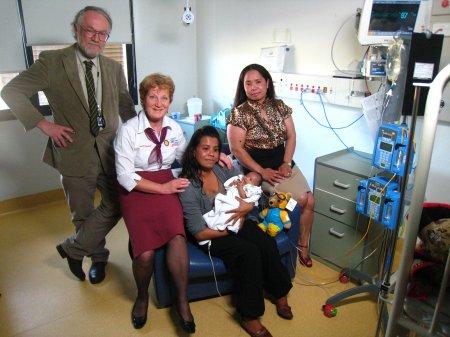Our miracle Timorese baby

When doctors at Canberra Hospital first saw four-day-old Santa from East Timor, her belly was covered with glad wrap in an attempt to keep her intestines from spilling out of her body.
Baby Santa was born with gastroschisis, a birth defect in which organs protrude from the body through a defect on one side of the umbilical cord. In Australia, more than 95% of babies born with gastroschisis survive, but in East Timor her mother, Maria, was told that her baby would have a very small chance of surviving.
The baby was admitted to the Neonatal ward in Dili and seen by specialists.
Australian paediatrician Ingrid Bucens, working in Dili, suggested that there was a possibility that treatment in Australia could give her baby the best possible chance of survival.
Paediatric surgeon Assoc/Professor David Croaker accepted care and The Canberra Hospital agreed to treat the little girl under a partnership agreement with ROMAC which helps children from developing countries afflicted with severe medical conditions. Time was a critical factor, with the risk of infection growing every minute.
Immigration officials rushed through a visa very quickly, allowing mother and daughter to fly to Darwin and onto Canberra for the life-saving surgery.
Professor Croaker said more than 100cm of the little girls’ intestines plus one ovary were outside the abdominal cavity. Santa was rushed to theatre where a silo was inserted in the cavity sealing off the bowel to prevent any further infection from the protruding bowel.
Santa had much bigger problems though; she now had an infection that the intensivists told us she had little chance of survival even with triple antibiotics. Santa was baptised that same evening. The first 24 hours of the best medical care and prayer was crucial.
The next 48 hours followed, Santa remained very sick but was holding her own. Each day was a blessing and a good day. Once the imminent emergency was over the doctors then began to reduce the silo with a gentle squeeze of the bowel back into the abdomen each day. After two weeks the bowel was reduced sufficiently to actually operate and close the abdominal wall.
Santa was extubated, breathing on her own with oxygen therapy only. Central lines remained feeding her nutrients, blood products, antibiotics and fluids. Gradually the bowel started to work. Santa was now 4 weeks old and remained in NICCU the whole time.
She was then transferred to the high dependency paediatric ward with the slow introduction to expressed breast milk, Santa continually vomited afterwards. A change to formula bottle feeds was necessary with a gradual increase in volume and a reduction of parental feeding.
Santa gained weight and was over 3.5kgs (arriving 2.2kgs) a bouncy baby, demanding cuddles and feeds. Maria is so thrilled to know her baby will survive and should be going home soon after Christmas.
The support for Maria from the Timor Leste Embassy was wonderful. A network of 4 families provided interpreting services, meals, emotional support and friendship at a much needed and scary time for Maria.
To be a part of a great team to save baby Santa is a wonderful experience. So many involved, so many who have cared for one little special baby.
More Patients Stories from East Timor
- Celestina – a decade later
- Complex heart surgery for Junitalia
- Miraculous surgical treatment saves Teretoriano
- Southern Cross, Christchurch save 3-y-o Timor-Leste child
- Adelaide responds to urgent surgery call
- Heldericky is not ashamed anymore
- A future ahead for brave Celestina
- Geovanio can now run with his friends
- Baby Quivania complex condition no barrier for ROMAC
- Baby Jofi Progressed Well After Cardiac Surgery

